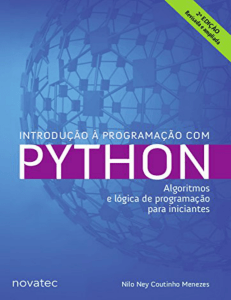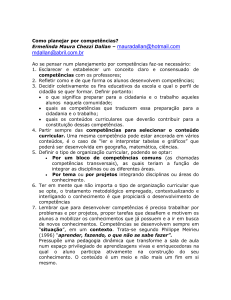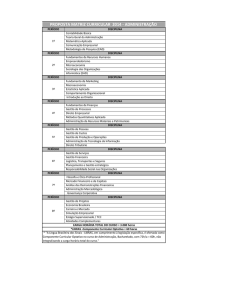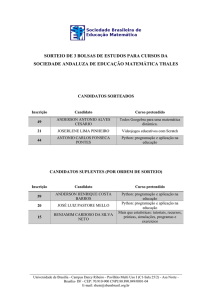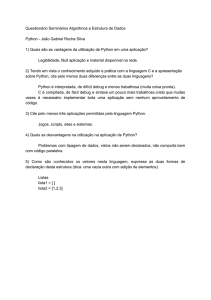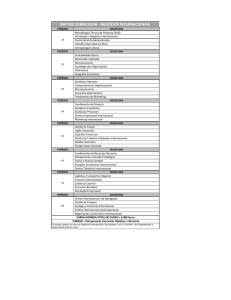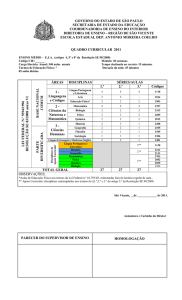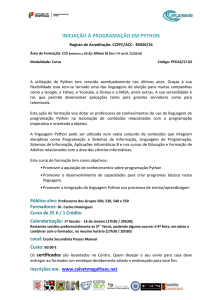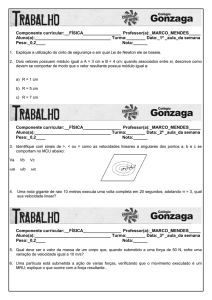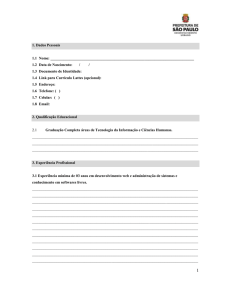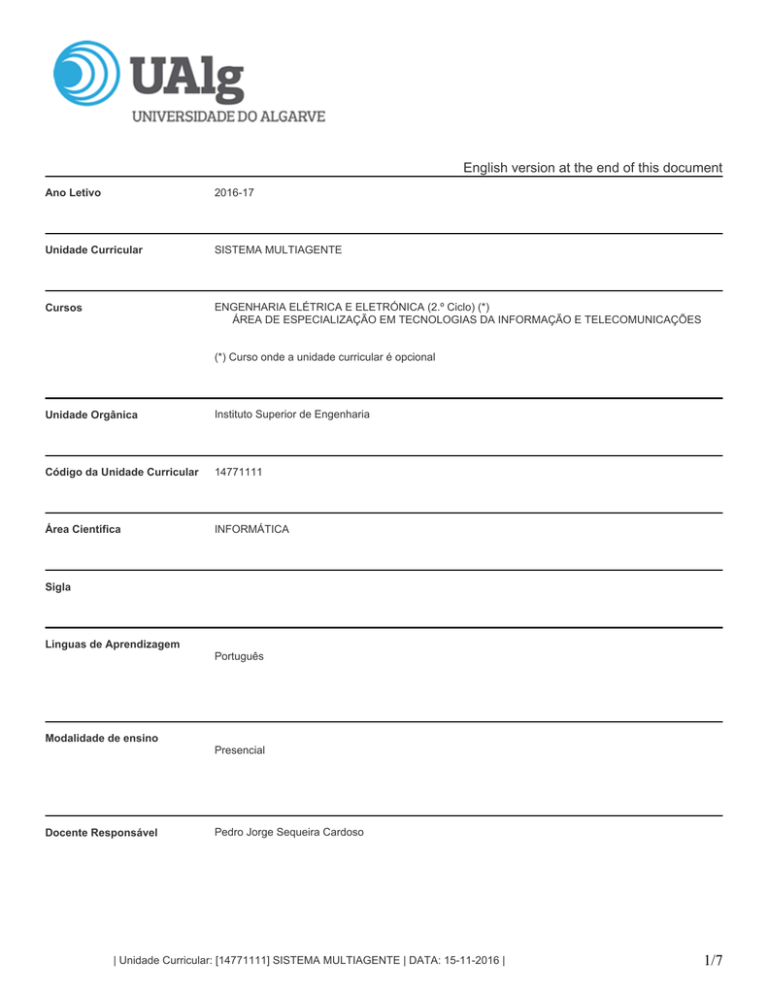
English version at the end of this document
Ano Letivo
2016-17
Unidade Curricular
SISTEMA MULTIAGENTE
Cursos
ENGENHARIA ELÉTRICA E ELETRÓNICA (2.º Ciclo) (*)
ÁREA DE ESPECIALIZAÇÃO EM TECNOLOGIAS DA INFORMAÇÃO E TELECOMUNICAÇÕES
(*) Curso onde a unidade curricular é opcional
Unidade Orgânica
Instituto Superior de Engenharia
Código da Unidade Curricular
14771111
Área Científica
INFORMÁTICA
Sigla
Línguas de Aprendizagem
Português
Modalidade de ensino
Presencial
Docente Responsável
Pedro Jorge Sequeira Cardoso
| Unidade Curricular: [14771111] SISTEMA MULTIAGENTE | DATA: 15-11-2016 |
1/7
DOCENTE
TIPO DE AULA
TURMAS
TOTAL HORAS DE CONTACTO (*)
Pedro Jorge Sequeira Cardoso
OT; PL; T; TP
T1; TP1; PL1; OT1
* Para turmas lecionadas conjuntamente, apenas é contabilizada a carga horária de uma delas.
15T; 30TP; 15PL; 5OT
ANO
PERÍODO DE FUNCIONAMENTO*
HORAS DE CONTACTO
HORAS TOTAIS DE TRABALHO
ECTS
1º
S2
15T; 30TP; 15PL; 5OT
280
10
* A-Anual;S-Semestral;Q-Quadrimestral;T-Trimestral
Precedências
Sem precedências
Conhecimentos Prévios recomendados
Conhecimentos básicos das linguagens de programação (em alternativa) C/C++/Java/python/matlab e algoritmia
Objetivos de aprendizagem (conhecimentos, aptidões e competências)
Introduzir conceitos e técnicas relacionadas com a implementação de agentes autónomos;
Introduzir técnicas de resolução distribuída de problemas;
Introduzir técnicas para projetar e implementar de um sistema multi-agente;
Estudo de técnicas clássicas de Inteligência Artificial (IA), para o caso multi-agente como, por exemplo, aprendizagem, raciocínio
probabilístico, planeamento, busca e lógica;
Estudo de teoria da decisão e teoria dos jogos em sistemas multi-agente;
Pretende-se ainda, de forma específica, que os alunos adquiram capacidades para:
Desenhar, analisar e implementar heurísticas e métodos utilizando sistemas multi-agente, nomeadamente:
Conhecer o funcionamento, compreender a utilidade e saber fazer uso das principais técnicas heurísticas para a resolução
de problemas;
Saber implementar as heurísticas mais relevantes
Saber analisar a complexidade e eficiência de um algoritmo.
Fazer uma rápida prototipagem com vista à resolução de problemas de otimização em engenharia.
| Unidade Curricular: [14771111] SISTEMA MULTIAGENTE | DATA: 15-11-2016 |
2/7
Conteúdos programáticos
Introdução à programação em Python
Conceitos gerais
Conceitos de otimização
Algoritmos genéricos: Paralelização algorítmica; Algoritmos meméticos / híbridos
Plataforma SPADE
Agentes inteligentes
Arquiteturas de agentes
Agentes cognitivos, reativos e híbridos
Sistemas Multi-Agentes
Estrutura (formas de organização)
Comunicação (ACL)
Negociação
Cooperação e coordenação de tarefas
Metodologias de desenvolvimento
Desenvolvimento de sistemas baseados em agentes
Algoritmos de Swarm Intelligence; (Sistema de Colónia de Formigas, Algoritmo de enxame de partículas, Bees algorithm)
Algoritmos evolutivos num SMA
Aplicações
simulação robótica - swarm robotics
robotcup (introdução)
netlogo
simulação de redes
Metodologias de ensino (avaliação incluída)
Metodologias de Ensino (máx. 1000 caracteres incluído avaliação)
Aulas Teórico-Práticas - exposição teórico-prática dos conteúdos
Tutoria - Orientação dos alunos na execução do trabalho e esclarecimento de dúvidas.
Avaliação
A avaliação é constituída por 4 trabalhos práticos sendo a nota final a média dos 3 melhores.
O aluno tem de ter a classificação mínima de 8 (oito) valores em pelo menos 3 dos trabalhos.
O docente poderá optar pela substituição do projeto final ou seminário por prova escritas relatórios ou outras formas de avaliação.
| Unidade Curricular: [14771111] SISTEMA MULTIAGENTE | DATA: 15-11-2016 |
3/7
Bibliografia principal
[1] M. Wooldridge(2009). An Introduction to MultiAgent Systems - Second Edition. John Wiley & Sons.
[2] Y. Shoham, K. Leyton-Brown (2008). Multiagent Systems: Algorithmic, Game-Theoretic, and Logical Foundations. Cambridge University
Press
[3] Alba, E., Blum, C., Asasi, P., Leon C., Gomez J. (2009), Optimization Techniques for Solving Complex Problems. Wiley.
[4] G. Ausiello, P. Crescenzi, G. Gambosi, V. Kann, A. Marchetti-Spaccamela, M. Protasi (1999), Complexity and Approximation:
Combinatorial Optimization Problems and Their Approximability Properties. Springer Verlag.
[5] Bonabeau, E., Dorigo, M., Theraulaz, G (1999), Swarm Intelligence: From Natural to Artificial Systems. Oxford University Press
[6] Dorigo, M., Stützle, T (2004), Ant Colony Optimization. Bradford Books.
[7] Glover, F., Laguna, M. (1997), Tabu Search. Kluwer Academic Publishers.
[8] Summerfield, M. (2008), Programming in Python 3: A Complete Introduction to the Python Language. Addison-Wesley Professional.
| Unidade Curricular: [14771111] SISTEMA MULTIAGENTE | DATA: 15-11-2016 |
4/7
Academic Year
2016-17
Course unit
SISTEMA MULTIAGENTE
Courses
ELECTRICAL AND ELECTRONICS ENGINEERING (*)
ÁREA DE ESPECIALIZAÇÃO EM TECNOLOGIAS DA INFORMAÇÃO E TELECOMUNICAÇÕES
(*) Optional course unit for this course
Faculty / School
Instituto Superior de Engenharia
Main Scientific Area
INFORMÁTICA
Acronym
Language of instruction
Portuguese
Learning modality
Presential
Coordinating teacher
Teaching staff
Pedro Jorge Sequeira Cardoso
Type
Pedro Jorge Sequeira Cardoso
OT; PL; T; TP
* For classes taught jointly, it is only accounted the workload of one.
Classes
T1; TP1; PL1; OT1
| Unidade Curricular: [14771111] SISTEMA MULTIAGENTE | DATA: 15-11-2016 |
Hours (*)
15T; 30TP; 15PL; 5OT
5/7
Contact hours
T
TP
PL
TC
S
E
OT
O
Total
30
15
0
0
0
5
0
280
15
T - Theoretical; TP - Theoretical and practical ; PL - Practical and laboratorial; TC - Field Work; S - Seminar; E - Training; OT - Tutorial; O - Other
Pre-requisites
no pre-requisites
Prior knowledge and skills
Basic knowledge of (in alternative): C / C + + / Java / Python / matlab
The students intended learning outcomes (knowledge, skills and competences)
- Introduce concepts and techniques related to the implementation of autonomous agents;
- Introduce solving techniques distributed problems;
Introduce techniques to design and implement a multi-agent system;
Study of classical Artificial Intelligence (AI) techniques for the multi-agent case (e.g., learning, probabilistic reasoning, planning,
search and logic);
Study of decision theory and game theory in multi-agent systems;
It is also intended, specifically, that students acquire skills to:
Design, analyse and implement methods and heuristics using multi-agent systems, including:
Know the operation, understand the usefulness and know how to make use of some of the main heuristic techniques
for solving problems;
Know how to implement some of the most relevant heuristics
Know how to analyse the complexity and efficiency of an algorithm.
Making rapid prototyping in order to solve optimization problems in engineering.
| Unidade Curricular: [14771111] SISTEMA MULTIAGENTE | DATA: 15-11-2016 |
6/7
Syllabus
Introduction to the Python programming language
SPADE plataform
Intelligent agents
Agents architecture
Cognitive, reactive and hybrid agents
Multi-Agent Systems
Structure (organizational forms)
Communication (ACL)
negotiation
Cooperation and coordination of tasks
Development methodologies
Development of agent-based systems
Swarm Intelligence algorithms
Optimization concepts
Generic algorithms: Algorithmic Parallelization; memetic / hybrids algorithms
Applications
robotics simulation - swarm robotics
robotcup (introduction)
NetLogo
Network simulation (NS-3)
Teaching methodologies (including evaluation)
Teaching and Learning Methods
T, TP, PL classes - theoretical exposure and practical implementation of the course contents
Tutoring - Orientation of students in the resolution of problems.
Assessment
The assessment consists of four practical works being the final grade average of the three best.
The student must have a minimum of eight (8) values in at least 3 of the work.
The teacher may choose to replace the final project or seminar reports by written evidence or other forms of assessment.
Main Bibliography
[1] M. Wooldridge(2009). An Introduction to MultiAgent Systems - Second Edition. John Wiley & Sons.
[2] Y. Shoham, K. Leyton-Brown (2008). Multiagent Systems: Algorithmic, Game-Theoretic, and Logical Foundations. Cambridge University
Press
[3] Alba, E., Blum, C., Asasi, P., Leon C., Gomez J. (2009), Optimization Techniques for Solving Complex Problems. Wiley.
[4] G. Ausiello, P. Crescenzi, G. Gambosi, V. Kann, A. Marchetti-Spaccamela, M. Protasi (1999), Complexity and Approximation:
Combinatorial Optimization Problems and Their Approximability Properties. Springer Verlag.
[5] Bonabeau, E., Dorigo, M., Theraulaz, G (1999), Swarm Intelligence: From Natural to Artificial Systems. Oxford University Press
[6] Dorigo, M., Stützle, T (2004), Ant Colony Optimization. Bradford Books.
[7] Glover, F., Laguna, M. (1997), Tabu Search. Kluwer Academic Publishers.
[8] Summerfield, M. (2008), Programming in Python 3: A Complete Introduction to the Python Language. Addison-Wesley Professional.
| Unidade Curricular: [14771111] SISTEMA MULTIAGENTE | DATA: 15-11-2016 |
7/7


